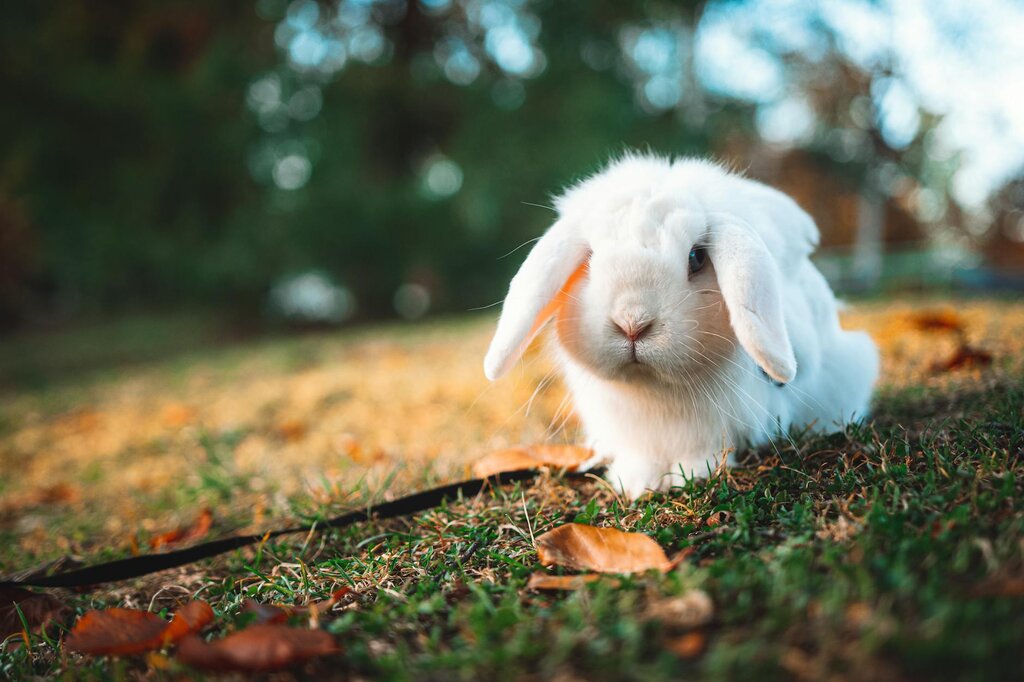Last Updated: 16/11/2025
Signs of Dental Disease in Rabbits
Learn all about the signs of dental disease in rabbits, with this vet written article.
Author: Dr Nicole Wynne BSc BVMS MANZCVS (Unusual Pets)
Reading Time: 5 minutes - short read
Does your rabbit have dental disease?
It can be scary to hear that your rabbit has dental disease. Whilst there are treatments to help with dental disease, unfortunately rabbits can never effectively be "cured" of dental disease once they are diagnosed.
Rabbits teeth grow continuously throughout their lives and require large amounts of abrasive fibre in the form of hay or grass in their diet to keep teeth worn down. Once dental disease is established the growth patterns of the teeth are permanently irregular. This is also true even after treatment to restore their teeth back to as normal a conformation as possible and is why lifelong management is necessary. As dental disease progresses it can also irreversibly damage the alveolar bone surrounding the teeth and jawbones, causing permanent effects.
Causes of dental disease include
- Diet - inadequate fibre from hay or grass or feeding high sugar or grain-based diets
- Skull or dental trauma
- Genetic factors
It is important to catch dental disease as early as possible, and it can be difficult as early signs can be as subtle as a change in chewing pattern.
Read on to find out what signs to look out for!
Signs of Dental Disease

Weight loss
Weight loss can be subtle and difficult to pick up, especially if it happens slowly over a period of time. Many rabbit owners only realise when they feel that their rabbit is bonier to the touch than usual. Weighing your rabbit weekly to fortnightly using small scales like paediatric scales and keeping a log of weights can help pick up weight loss before it becomes deathly apparent.
Body Condition Scoring is also useful for picking up signs of illness in your rabbit. Underweight or skinny rabbits will have easily palpable hip bones, ribs and spine, which may be sharp to the touch. A lack of muscle and fat cover with a flat rump area can be another sign of an underweight rabbit.
Changes in chewing
Depending on what is going on with the teeth, the rabbit may start to chew differently, or only use one side of their mouth to chew. They may also open their mouths wider than normal, or drop food. Rabbit's have a distinctive way of chewing, usually chewing in circular, side to side motions to help keep their teeth at a comfortable length. Rabbit's with dental disease may develop painful spurs or sharp points to the edges of their cheek teeth due to uneven wear which will alter their chewing.
Drooling
Any oral pain or discomfort can cause drooling, and this normally shows up as wet patches around the face, mouth, and chin. This may also cause the fur around the mouth to smell and fall out. Fur may also be discoloured yellow or green.
Watery eyes
Watery eyes or "epiphora" in rabbits is due to blockage and/or chronic inflammation of the tear ducts. Rabbit tear ducts are very narrow and long, and lie over the roots of the cheek teeth. When these ducts become blocked or inflamed, tears are unable to drain into the nose. It can affect one or both eyes, and is often caused by dental disease or by non dental related illnesses.
Asymmetry of the face
If your rabbits face appears lopsided, or you feel bumps or hard spots that are not present on the other side, this may be due to abnormal dental or jawbone changes, facial abscesses, or excessive tooth growth. Common places for these lumps and bumps to appear include around or under the eyes, along the jaw and near the chin.
Teeth poking out from the lips
When the front teeth aka the incisors do not align it takes away the natural ability of these teeth to wear down normally, causing unrestricted growth, which may cause rabbits to grow walrus-like teeth. Malocclusion of the incisors can be congenital in nature, secondary to cheek teeth problems or from trauma.
Reduced appetite
Eating more slowly or choosing different foods than before may be due to dental disease. Most commonly rabbits will stop eating hay or preferentially eat other foods like greens or pellets over hay because hay is harder to chew. Rabbits may also initially appear enthusiastic about food, then fail to eat, or eat slowly and drop food as they go. This may also be an early sign of gut stasis. Check out our article on Gut Stasis for more information.
Bad breath
There's nothing better than bunny licks, except when that bunny has a stinky breath. Rabbits do not normally have bad breath, and it is a sign that there may be infection or ulceration in the mouth. Excessive drooling can also cause bad breath.
Changes in behaviour
Discomfort may cause a normally laid back rabbit to become grumpy and aggressive, or a rabbit that used to be clean may start to get unkempt and dirty. Rabbits with dental disease may also hide away and become more quiet and lethargic. Signs of pain in prey animals like rabbits are very subtle and can include: teeth grinding, rapid and shallow breathing, a hunched posture, a lack of movement and/or narrowed or squinting eyes.
Matted or soiled coat
Rabbits are meticulous groomers and like to keep themselves very clean. If they have dental changes and oral pain this makes grooming a lot more difficult. Rabbits with an unkempt coat, fur matts or a messy bottom with urine and/or faecal soiling may be suffering from dental disease.
Diagnosing and Managing Dental Disease

Unlike dogs and cats it is difficult to examine the cheek teeth of a rabbit whilst conscious. Rabbits have a total of 28 teeth, 6 at the front and 22 at the back and their oral cavity is quite small and much of the tooth is hidden below the gumline. Special equipment is needed to assess these teeth during a routine physical exam and even then the view of these teeth is limited. In fact only up to 50% of dental changes can be seen on a conscious oral exam.
Whilst some changes may be obvious on physical exam, an accurate diagnosis of dental disease includes a thorough examination of the teeth and oral cavity under sedation or anaesthetic combined with diagnostic imaging such as radiographs or CT scans.
Once a thorough assessment of the teeth has been made, management of dental disease may include burring the teeth to return their length and occlusion to as close as normal, removing any diseased teeth where warranted and treating any infections or abscesses.
If you are concerned that your rabbit may have dental disease, book an appointment with your vet ASAP. Regular health checks with an experienced exotics veterinarian every 6-12 months is essential for maintaining your pet's health.
Shop some hay products for rabbits
Rabbit dental disease can seem intimidating, but understanding the signs and taking proactive steps can make a massive difference to your bunny's quality of life. Don't underestimate the impact of dental health—it's often the root of many chronic rabbit health issues!
Articles recommended for you
Our vet authored guide to the benefits of feeding your dog fresh food plus tips and advice for introducing it into their regular menu.
See our guide to protecting your pet from parasites from our vet team.
Thinking of getting a fish? Check out our guide for setting up a tank and home care tips!
Looking to understand horse feeds better? This comprehensive guide covers feeding recommendations for horses of all ages and disciplines.
Does your pet suffer from anxiety? Check out our Vet-guide for treatment options to help your pet.
History
Our experts continually monitor the health and wellness space and we update our articles when new information becomes available.
Mon 17 Nov 2025
Edited by Dr Olivia Clarke BSc BVMS MANZCVS (Unusual Pets, Avian)Medically reviewed by Dr Olivia Clarke BSc BVMS MANZCVS (Unusual Pets, Avian)Dr Nicole Wynne BSc BVMS MANZCVS (Unusual Pets)
Veterinarian, MANZCVS (Unusual Pets)
Dr. Nicole graduated from Murdoch University in WA in 2014, and immediately started working in exotics-only practice. She was also one of the few vets in Australia that would routinely see venomous snakes ranging from death adders to tiger snakes. Although Dr. Nicole enjoys seeing all exotic pets, her absolute favourite are rabbits. She passed her Australian and New Zealand College of Veterinary Scientists Membership (MANZCVS) exam in unusual and exotic pets in 2021.

